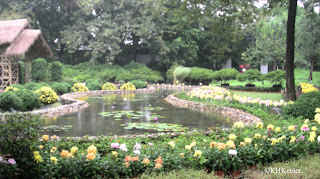 |
| red chrysanthemums |
My garden is in Colorado but those are Chinese plants or plants also found in China. In the late 1800s and early 1900s "plant hunters" searched east Asia for garden plants. Many familiar garden plants--lilacs, peonies, ever-blooming roses, nandina, butterfly bush--are native to China, introduced to the West by the plant hunters.
 |
| Chrysanthemums along the garden wall, Suzhou, China |
The Chinese Chrysanthemum
Traditional Chinese culture noticed the progress of the seasons and cherished it. Plants were associated with seasons--plum blossoms in spring, orchid in summer, chrysanthemum with fall, bamboo in winter--to name The Four Gentlemen, also known at the Four Plants of Virtue. The right plant for the season was important. Having plants out of season brought bad luck.
Chrysanthemums ( jú in Chinese) have been cultivated in China since about 700 BC. There, raising chrysanthemums has, for millennia, been a respectable and desirable activity for retirees. Probably there is double meaning here of flowers of autumn and the autumn of life.
 |
| hedge of chyrsanthemums, Suzhou, China |
Traditionally the Chinese used a variety of fragrant plants and flowers as indoor air fresheners. In fall they set out masses of chrysanthemums in pots for that purpose, indoors and in the courtyards of their homes. Of course it brightened the spot, but in addition there was a long-held belief that the scent of chrysanthemums extended life. In that sense, chrysanthemum was the flower of immortality.
This level of Interest in chrysanthemums produced literally thousands of shapes and colors, the shapes and colors of chrysanthemums in the West are a small portion of those in China.
Chrysanthemums in the West:
There about 40 species in the genus Chrysanthemum, mainly in China. Despite their long history of cultivation--chrysanthemum has been the national plant of Japan since 910AD--chrysanthemums, were first brought to Europe about 1680. These apparently died out. A reintroduction in the 1700s also died. About 1800 chrysanthemums became common European garden plants. The exact introduction of "mums," to the U.S. is unclear, but was probably about 1800.
The scientific name is confused because the first plant called Chrysanthemum was a small European flower. Later, Linnaeus put the plants from China and Japan into Chrysanthemum. In 1961, a detailed analysis by the Russian botanist Tzvelev split the genus. The name Chrysanthemum went with that first flower and not with the garden chrysanthemums (our mums). The International Association of Plant Taxonomists eventually passed a rule giving the scientific name Chrysanthemum to the garden chrysanthemum. So chrysanthemums were Dendranthema species for a number of years but in 1995 they became Chrysanthemum species again. A surprising number of the sites on the internet that talk about chrysantheumums still call them Dendranthema. As far as I can tell, all the Dendranthema species became Chrysanthemum species in 1995, so there no longer are any plants with the scientific name Dendranthema.
Chinese Chrysanthemums in Autumn
The scientific name is confused because the first plant called Chrysanthemum was a small European flower. Later, Linnaeus put the plants from China and Japan into Chrysanthemum. In 1961, a detailed analysis by the Russian botanist Tzvelev split the genus. The name Chrysanthemum went with that first flower and not with the garden chrysanthemums (our mums). The International Association of Plant Taxonomists eventually passed a rule giving the scientific name Chrysanthemum to the garden chrysanthemum. So chrysanthemums were Dendranthema species for a number of years but in 1995 they became Chrysanthemum species again. A surprising number of the sites on the internet that talk about chrysantheumums still call them Dendranthema. As far as I can tell, all the Dendranthema species became Chrysanthemum species in 1995, so there no longer are any plants with the scientific name Dendranthema.
Chinese Chrysanthemums in Autumn
Chinese color symbolism is different from western color symbolism. First, white is strongly associated with death. Except at a funeral, do not give anyone white flowers in China. On the other hand, yellow, which has a lot of negative meanings in the West, was the Emperor's color and so had and has all kinds of strong, royal associations. Red for the Chinese was the color of joy. Brides wear red to weddings. So for the Chinese, yellow and red chrysanthemums.
 |
| chrysanthemums and pond, Suzhou, China |
What non-Chinese speakers don't see when the painted bowl has a chrysanthemum and maple leaves is the pun. Chinese is very very rich in words with the same sound but different meanings. English has pair and pear, green plant and manufacturing plant, and, my favorite, dye and die.( "My friend and I are dyeing today.") Chrysanthemum, jú has nearly the same pronunciation as jŭ which means entire or whole. Maple is fēng. Fēng also means lush, abundant. Consequently the phrase chrysanthemum maple, jú fēng, can alternately be read "abundant whole", that is "live and work in peace and contentment."
Happy fall to you. Chrysanthemum and maple. Jú fēng.
Comments and corrections welcome.
Comments and corrections welcome.
References
Miles, T. 2004. Chrysanthemum. Bellarmine University. accessed 9/8/13
National Chrystanthemum Society, USA homepage. History is under Journal Accessed 9/8/13.
Needham, J. 1986. Science and Civilization in China. VI: 1 Botany. Cambridge University Press, Cambridge.
Needham, J. 1986. Science and Civilization in China. VI: 1 Botany. Cambridge University Press, Cambridge.
Valder, P. 1999. The Garden Plants of China. Timber Press, Portland, OR.
Welch, P. B. 2008. Chinese Art. A Guide to Motifs and Visual Imagery. Tuttle Press, Tokyo.
More at awanderingbotanist.com
Join me on Facebook
No comments:
Post a Comment